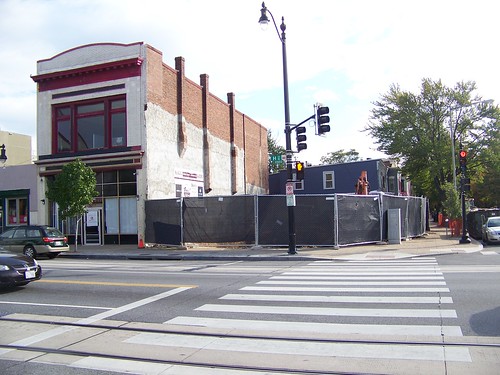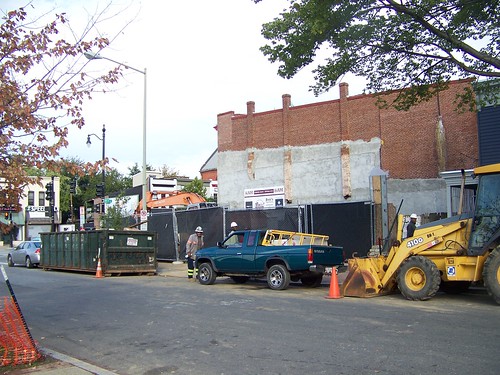Ben's Chili Bowl demolishes 1001 H Street NE: Illegal demolition illustrates failures in DC's regulatory system
Historic buildings are the building blocks of successful urban commercial districts
As discussed in a previous entry ("Millennials, hipness, "rowhouse-y charm," and authenticity") it is the historic--eligible for designation or actually designated--building stock in neighborhood commercial districts that is the basic building block for "cool" "edgy" "interesting" "attractive" places to visit.
The link between urban revitalization and historic preservation is long standing. In fact, I am pretty much convinced that historic preservation strategies are one of the only sustainable methods for urban revitalization (transit helps, but isn't absolutely required) that there is. The Main Street program is based on this concept, and there are plenty of other studies and work that demonstrates the link.
 Lately I am particularly enamored of the writings by John Montgomery, a professor and consultant involved in early culture and creative industries driven urban revitalization efforts in the late 1980s and early 1990s. His book The New Wealth of Cities: City Dynamics and the Fifth Way, is probably the best single discussion of virtually every aspect of culture district based revitalization (even better than Cities: Back from the Edge, which is equally great and I will say, easier to read, but is not quite the same as a primer), including the historic preservation element. I wish we would have known about JM's work when we started the H St. Main Street organization.
Lately I am particularly enamored of the writings by John Montgomery, a professor and consultant involved in early culture and creative industries driven urban revitalization efforts in the late 1980s and early 1990s. His book The New Wealth of Cities: City Dynamics and the Fifth Way, is probably the best single discussion of virtually every aspect of culture district based revitalization (even better than Cities: Back from the Edge, which is equally great and I will say, easier to read, but is not quite the same as a primer), including the historic preservation element. I wish we would have known about JM's work when we started the H St. Main Street organization. More recently, the World Bank published The Economics of Uniqueness: Investing in City Cores and Cultural Assets for Sustainable Development which focuses more on the historic preservation/heritage conservation element.
In DC, only historically designated areas "enjoy" extra-normal protections such as more careful design review and restrictions on demolition
The reason the link between historic buildings and urban revitalization is worth mentioning is that it provides justification for regulating what happens to buildings in commercial districts.
About 10 years ago, I submitted testimony with regard to DC's Department of Housing and Community Development and the Main Street program, suggesting that as part of the creation of a Main Street district, development review guidelines and building protections should be put into place, regardless of the historic designation status of the district.
A demolition on H Street NE demonstrates the gap in DC laws
A few days ago, Ben's Chili Bowl, which bought 1001 H Street NE (two buildings) for a new location ("For Ben's Chili Bowl, expansion comes with responsibility," Washington Post) demolished the building, even though they submitted plans to the city's Building and Land Regulation Agency for renovation and never applied for a demolition permit. Despite the demolition, there isn't a stop work order posted on the property (at least as of yesterday afternoon, when I went by).
One of the provisions in the "Neighborhood Commercial District Overlay" discourages demolition by given a space utilization (or FAR, floor-to-area ratio) bonus. What this means is that property owners can use more of the site if they keep an historically eligible building rather than tear it down. Ben's was given that bonus, based on their submitted plans, but based on the demolition, they are not eligible for it. But it's not the same as the Cleveland regulation.
Many years ago, rather than fix this projecting bay turret on the building at 1128 H Street NE, the then property owner had it parged (stuccoed). Photo from Loopnet.
DC's regulation is based on the hope that there is goodwill and appreciation for historicity on the part of the property owner.
But I would think that the myriad examples of lousy work and boneheaded acts by property owners across the city would convince us that being hopeful isn't a good strategy.
DC needs building protections in commercial districts, whether or not these districts are historically designated
1. One example would be how Cleveland has a zoning classification called a "Business Revitalization District," which requires design review and development coordination for all projects in designated revitalization districts (H Street would be considered such a district in the context of Cleveland's regulations). This is to ensure that property owners don't take actions that diminish, rather than assist, revitalization. From the Cleveland webpage:
Certain proposals for construction, exterior alterations, building demolitions or signs in the City of Cleveland must undergo a process known as "design review." The City established this process as a policy to ensure that any visual changes to buildings or open spaces will enhance the architectural character of Neighborhood Commercial Districts.2. Ultimately, even in a historic district, you can't prevent a company from breaking the law if that's what they want to do. So buildings do get demolished, despite the best efforts of government officials and building inspectors.
The way to prevent this from happening is to have serious penalties.
Some jurisdictions--not DC--have provisions in the law so that illegal demolitions are "cured" by a complete rebuilding of the property.
But in DC, other than a wee fine, nothing of substance will happen to the company, and DC loses buildings that are more than 100 years old.
And to require that buildings be saved, or at least very difficult to tear down.
A more robust regulation like Cleveland's is definitely in order.
3. Another penalty to consider assessing would be on the firms/employees that performed the illegal demolition, forbidding authorization to work on projects in DC for a period of 18 months or more.
Flickr image of 1001 H Street NE by Inked78

Google Street View Image

Image from yesterday

Sign on the wall of the adjoining building, announcing the coming of Ben's to the H Street corridor

Yesterday, despite the illegal demolition, no stop work notice had been posted, and workers were on site.

Labels: building regulation, commercial district revitalization, commercial district revitalization planning, demolition, historic preservation, zoning




6 Comments:
Bens will not get any stop work order because they too well connected to the PG county junta that runs the DC government
http://www.youtube.com/watch?v=GyxLGSMtqtM
I know the main topic is the tear down, but I appreciate your mention of that stuccoed turret at 12th & H. It is really ugly and it has always stuck in my craw that the building's owners can get away with something so half-assed. I would be embarrassed to be the owner of that building.
The reason that I am pretty adamantly in favor of historic preservation, design review, and other related building regulations is because (1) historic architecture is fundamental to the identity of DC and especially its pre-WWII neighborhoods and (2) because virtually every example of when people are left to their own devices and "taste" they fu*k it up so so so so so so badly, that quality when it happens is the exception that proves the rule of the necessity of regulatory oversight.
The turret is but one example. And I am not involved in H St. stuff anymore, maybe you are. I heard that there is a facade improvement program going on in the corridor. Fixing that turret should be one of the topmost priorities of such a program.
When I was involved in such programs in the past, I always recommended focusing on projects with either the greatest need or the greatest possible positive visual impact. This turret is probably the #1 such example of a needed improvement on H St.
FWIW, when I mentioned my DHCD testimony from years ago (I can't find it digitally unfortunatelyl), it was sparked in large part by a then facade program on the H St. corridor run by the CDC, and how it spent money but accomplished very little. (And also the demolition of historic buildings and their replacement by that hideous building at the SW corner of 8th and H Streets NE.)
... such improvements make a huge difference. For decades, the upper story windows of the dry cleaners on the NE corner of 11th and H were boarded up. Around 2002 or 2003 the owner opened them back up (it might have been from a facade program, but I don't think so). It made a huge difference, and was one of a handful of positive moves by individual property owners that presaged later improvements, but at the time it really helped change the perception positively about the possibility of improvements.
Now the space is rented out to Maid Pro according to Google Street View... Far better than leaving it boarded up and vacant.
It's ironic when you consider that the primary reason Ben's Chili Bowl on U Street is a beloved "Washington Landmark" is its historic character and genuine old-time atmosphere.
Post a Comment
<< Home